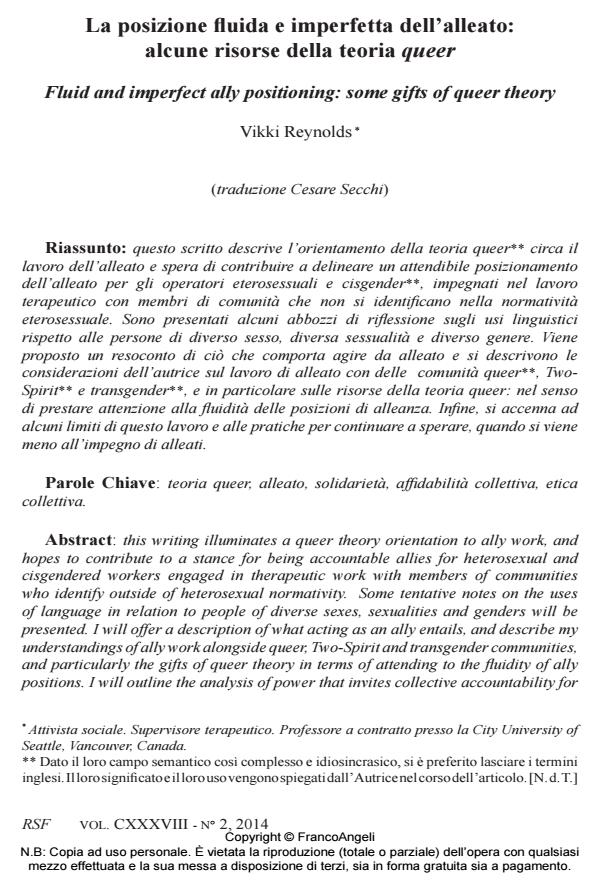La posizione fluida e imperfetta dell’alleato: alcune risorse della teoria queer
Titolo Rivista RIVISTA SPERIMENTALE DI FRENIATRIA
Autori/Curatori Vikki Reynolds
Anno di pubblicazione 2014 Fascicolo 2014/2 Lingua Italiano
Numero pagine 15 P. 129-143 Dimensione file 1602 KB
DOI 10.3280/RSF2014-002009
Il DOI è il codice a barre della proprietà intellettuale: per saperne di più
clicca qui
Qui sotto puoi vedere in anteprima la prima pagina di questo articolo.
Se questo articolo ti interessa, lo puoi acquistare (e scaricare in formato pdf) seguendo le facili indicazioni per acquistare il download credit. Acquista Download Credits per scaricare questo Articolo in formato PDF

FrancoAngeli è membro della Publishers International Linking Association, Inc (PILA)associazione indipendente e non profit per facilitare (attraverso i servizi tecnologici implementati da CrossRef.org) l’accesso degli studiosi ai contenuti digitali nelle pubblicazioni professionali e scientifiche
Questo scritto descrive l’orientamento della teoria queer** circa il lavoro dell’alleato e spera di contribuire a delineare un attendibile posizionamento dell’alleato per gli operatori eterosessuali e cisgender**, impegnati nel lavoro terapeutico con membri di comunità che non si identificano nella normatività eterosessuale. Sono presentati alcuni abbozzi di riflessione sugli usi linguistici rispetto alle persone di diverso sesso, diversa sessualità e diverso genere. Viene proposto un resoconto di ciò che comporta agire da alleato e si descrivono le considerazioni dell’autrice sul lavoro di alleato con delle comunità queer**, Two- Spirit** e transgender**, e in particolare sulle risorse della teoria queer: nel senso di prestare attenzione alla fluidità delle posizioni di alleanza. Infine, si accenna ad alcuni limiti di questo lavoro e alle pratiche per continuare a sperare, quando si viene meno all’impegno di alleati.;
Keywords:Teoria queer, alleato, solidarietà, affidabilità collettiva, etica collettiva.
- [1] Bishop A. Becoming an ally: Breaking the cycle of oppression. Halifax, Canada: Fernwood; 1994.
- [2] Fassinger R, Arsenau J. “I’d rather get wet than be under the umbrella”: Differentiating the experiences and identities of lesbian, gay, bisexual, and transgender people. In: Bieschke KJ, Perez RM, Debord KA, ed. Handbook of counseling and psychology with lesbian, gay, bisexual and transgender clients (2nd ed). Washington, DC: American Psychological Association; 2007, p. 19-50.
- [3] Munro A. Comunicazione personale; 2010.
- [4] Butler J. Gender trouble: Feminism and the subversion of identity. New York, NY: Routledge; 1990.
- [5] MacFarlane D. Comunicazione personale; 2009.
- [6] Kelly J. Comunicazione personale; 2010.
- [7] Nataf Z. Lesbians talk transgender. London, UK: Scarlet Press; 1996.
- [8] O’Brien-Teengs D. Two spirit women (2nd ed.). Retrieved from http://www.2spirits.com/; 2008.
- [9] Bornstein K. Gender outlaw: On men, women and the rest of us. New York, NY: Routledge; 1994.
- [10] Butler J. Excitable speech: A politics of the performative. New York, NY: Routledge; 1997.
- [11] Jagose A. Queer theory: An introduction. Melbourne, Australia: Melbourne University Press; 1996.
- [12] Queen C, Schimel L. Homosexuals: Challenging assumptions about gender and sexuality. San Francisco, CA: Cleis Press; 1997.
- [13] Robinson T. The convergence of race, ethnicity, and gender: Multiple identities in counseling (2nd ed.). Boston, MA: Pearson Education; 2005.
- [14] Day R. Gramsci is dead: Anarchist currents in the newest social movements. London: Pluto Press; 2005.
- [15] Crenshaw K. Mapping the margins: Intersectionality, identity politics, and violence against women of colour. In: Crenshaw K, Gotanda G, Peller G, Thomas K, ed. Critical race theory: The key writings that formed the movement. New York, NY: The New Press; 1995, p. 357-383.
- [16] Freire P. Pedagogy in process: The letters to Guinea Bissau. New York, NY: Seabury Press; 1978.
- [17] Lacey A. Spaces of justice: The social divine of global anti-capital activists’ sites of resistance. CRSA/RCSA 2005; 42(4): 407.
- [18] Reynolds V. Collective ethics as a path to resisting burnout. Insights: The Clinical Counsellor’s Magazine & News December 2009; 6-7.
- [19] McNamee S, Gergen K. Relational responsibility: Resources for sustainable dialogue. London, UK: Sage; 1999.
- [20] Tamasese K. Talking about culture and gender. In White C, ed. Working with the stories of women’s lives. Adelaide, Australia: Dulwich Centre; 2001, p.15-22.
- [21] Kvale S. Inter-views: An introduction to qualitative research interviewing. London, UK: Sage; 1996.
- [22] Tuhiwai Smith L. Decolonizing methodologies: Research and indigenous peoples. London, UK: Zed Books; 1999.
- [23] Lee S. (Producer/Writer/Director). Do the Right Thing (Motion Picture). United States: 40 Acres & A Mule Filmworks; 1989.
- [24] Freire P. Pedagogy of freedom: Ethics, democracy and civic courage. Lanham, MD: Rowman and Littlefield; 2001.
- [25] Peltier L. Prison writings: My life is my Sundance. New York, NY: St. Martin’s Press; 1999.
- [26] Reynolds V. Fluid and Imperfect Ally Positioning: Some Gifts of Queer Theory. Context, October 2010. Association for Family and Systemic Therapy, UK, 13-17.
Vikki Reynolds, La posizione fluida e imperfetta dell’alleato: alcune risorse della teoria queer in "RIVISTA SPERIMENTALE DI FRENIATRIA" 2/2014, pp 129-143, DOI: 10.3280/RSF2014-002009